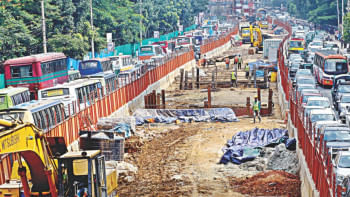Is the metro rail really opening tomorrow?

We are now days away from the decade-old dream of walking for a couple of minutes from your home in the morning or from your office in the afternoon, reaching the closest station, going up the escalator after swiping your smart card at the gate, and waiting for a maximum of only 2-3 minutes for your train – getting on knowing that you will reach your destination on time, that too in the city that we all love to hate because of traffic. The first ever Dhaka Metro Rail will be inaugurated on December 28 by the prime minister and will be open to us, the public, from December 29. However, whether we can truly consider this the actual beginning of our dream "life in a metro" is doubtful.
The work of the MRT Line-6 began officially in 2012. The plan was always to inaugurate the first half of Uttara to Agargaon before completing the whole line from Uttara to Motijheel (Later extended to Kamlapur). Initially, the project was supposed to be completed in 2019 but it has been delayed, for one year every year, before finally being set to "open" in 2022. But turns out, we will have to wait quite a bit longer for the metro rail to be fully operational, and for it to be an accessible public transport option for mass use.
Following the inauguration tomorrow, the metro rail will open to the public on a limited scale. The trains themselves will move slower than the usual speed. This means getting from one station to another will take longer. The carrying capacity of each train will also be significantly reduced. Around 200-250 people will board the trains for now, which are meant to have a capacity for around 700-800 passengers. This means getting on the train will be a challenge, especially since huge crowds are expected to flock to the stations to experience the country's first-ever metro rail.
The trains will also not stop at all the stations as they're supposed to. In fact, from Uttara, the trains will stop only once in Pallabi and then go straight to Agargaon. The number of carriages will also be less than full capacity, with only 10 operating instead of 24. And to round it all off, the trains will be operational only for a short duration of four hours in the morning from 8 am. So at best, we could call this a trial period, because the number of people who will actually be able to commute using the metro rail is going to be a few thousand maximum per day. Which is not even a scratch on the surface of the full potential carrying capacity of around five lakhs per day.

Now, the authorities are stating that a number of these steps are being taken in order to get people used to using the metro for the first time. That is why the trains will also stop at the stations for longer periods.
However, none of the other reasons seem logical in terms of getting people up to speed on efficiently using the metro. Because how can people be acquainted with the metro if they can't even get on it?
Another recent development is the announcement of no discounted passes for students. Although students are heavily reliant on public transport, the minimum fare for the metro has been set at Tk 20. Given that this is twice the minimum bus fare, it is highly unlikely that students will opt to use the metro instead of their usual modes of transport.
It almost feels like the government is rushing a half-hearted launch of the metro to divert the conversation from how this December was supposed to be a huge month for Dhaka commuters with the opening of three of the biggest projects focused on reducing traffic – The Dhaka Metro Rail, The Bus Rapid Transit and The Dhaka Elevated Expressway. It has now been hinted that the latter two will be opening next year, but there is still no specific deadline. Given that the number of government projects that missed their deadline in the 2021-22 fiscal year was 63 percent higher than that in the previous year, which have gone hand in hand with massive cost escalations, this does not bode well for any future plans to reduce traffic congestion in the city.
Dhaka's state of traffic is starting to feel a lot like being trapped in a never-ending nightmare. The three mega-projects the government promised to deliver this year have a long way to go yet before they can effectively deal with the situation, and this includes the metro rail. As things stand now, the second section of the metro, from Agargaon to Motijheel, is projected to open in December next year, and the third section from Motijheel to Kamalapur Railway Station will take even longer.
So despite our long-cherished dream of regular, hassle-free commutes becoming a daily part of our lives, it seems we will have to keep looking up at mostly empty rail tracks while continuing to sit in traffic, which has ironically increased significantly in certain parts of the city due to the construction of the metro rail.

 For all latest news, follow The Daily Star's Google News channel.
For all latest news, follow The Daily Star's Google News channel. 






Comments